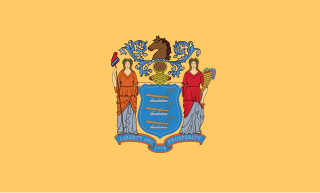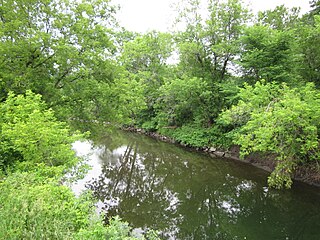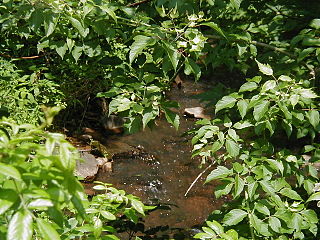| First River | |
| River | |
| Country | United States |
|---|---|
| State | New Jersey |
| Counties | Essex |
| Mouth | Passaic River |
| - location | Newark, Essex , New Jersey , United States |
This article needs additional citations for verification .(March 2017) (Learn how and when to remove this template message) |
The First River, in the state of New Jersey in the United States, is a subterranean river and the first main tributary of the Passaic River encountered while travelling upstream from its mouth at Newark Bay.

New Jersey is a state in the Mid-Atlantic and Northeastern regions of the United States. It is located on a peninsula, bordered on the north and east by the state of New York, particularly along the extent of the length of New York City on its western edge; on the east, southeast, and south by the Atlantic Ocean; on the west by the Delaware River and Pennsylvania; and on the southwest by the Delaware Bay and Delaware. New Jersey is the fourth-smallest state by area but the 11th-most populous, with 9 million residents as of 2017, and the most densely populated of the 50 U.S. states; its biggest city is Newark. New Jersey lies completely within the combined statistical areas of New York City and Philadelphia. New Jersey was the second-wealthiest U.S. state by median household income as of 2017.

The United States of America (USA), commonly known as the United States or America, is a country composed of 50 states, a federal district, five major self-governing territories, and various possessions. At 3.8 million square miles, the United States is the world's third or fourth largest country by total area and is slightly smaller than the entire continent of Europe's 3.9 million square miles. With a population of over 327 million people, the U.S. is the third most populous country. The capital is Washington, D.C., and the largest city by population is New York City. Forty-eight states and the capital's federal district are contiguous in North America between Canada and Mexico. The State of Alaska is in the northwest corner of North America, bordered by Canada to the east and across the Bering Strait from Russia to the west. The State of Hawaii is an archipelago in the mid-Pacific Ocean. The U.S. territories are scattered about the Pacific Ocean and the Caribbean Sea, stretching across nine official time zones. The extremely diverse geography, climate, and wildlife of the United States make it one of the world's 17 megadiverse countries.

A subterranean river is a river that runs wholly or partly beneath the ground surface – one where the riverbed does not represent the surface of the Earth. It should also not be confused with an aquifer which may flow like a river but is contained within a permeable layer of rock or other unconsolidated materials.
Beginning at the confluence of Mill Brook and Branch Brook [1] (near the present Skating Center in Branch Brook Park), the First River flowed parallel to Seventh Avenue and Clay Street, discharging into the Passaic River in the vicinity of the Clay Street bridge.

Branch Brook Park is a county park of Essex County, New Jersey in the United States, located in the North Ward of Newark, between the neighborhoods of Forest Hill and Roseville. A portion of the park is also located within the Township of Belleville. At 360 acres (150 ha), Branch Brook Park is the largest public park in the city of Newark. The park is noted for the largest collection of cherry blossom trees in the United States, having over 5,000 in more than eighteen different varieties collectively called Cherryblossomland, as well as its spectacular Cherry Blossom Festival each April.
The First River was also known as Mill Brook, having supported several mills, including grist mills for the earliest settlers of Newark in the 17th century.

A watermill or water mill is a mill that uses hydropower. It is a structure that uses a water wheel or water turbine to drive a mechanical process such as milling (grinding), rolling, or hammering. Such processes are needed in the production of many material goods, including flour, lumber, paper, textiles, and many metal products. These watermills may comprise gristmills, sawmills, paper mills, textile mills, hammermills, trip hammering mills, rolling mills, wire drawing mills.
From 1863 to 1890 the brook was culvertised and now flows underground through two culverts, each six feet nine inches (206 cm) high by nine feet three inches (282 cm) wide until discharging into the Passaic. [2] The brook once flowed through, and now flows under, what is now Branch Brook Park in the city of Newark. [3]

A culvert is a structure that allows water to flow under a road, railroad, trail, or similar obstruction from one side to the other side. Typically embedded so as to be surrounded by soil, a culvert may be made from a pipe, reinforced concrete or other material. In the United Kingdom, the word can also be used for a longer artificially buried watercourse.

Newark is the most populous city in the U.S. state of New Jersey and the seat of Essex County. As one of the nation's major air, shipping, and rail hubs, the city had a population of 285,154 in 2017, making it the nation's 70th-most populous municipality, after being ranked 63rd in the nation in 2000.














